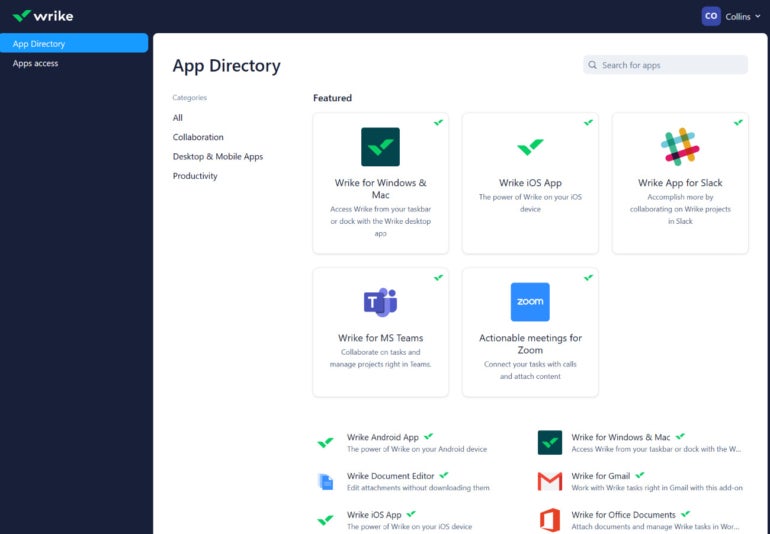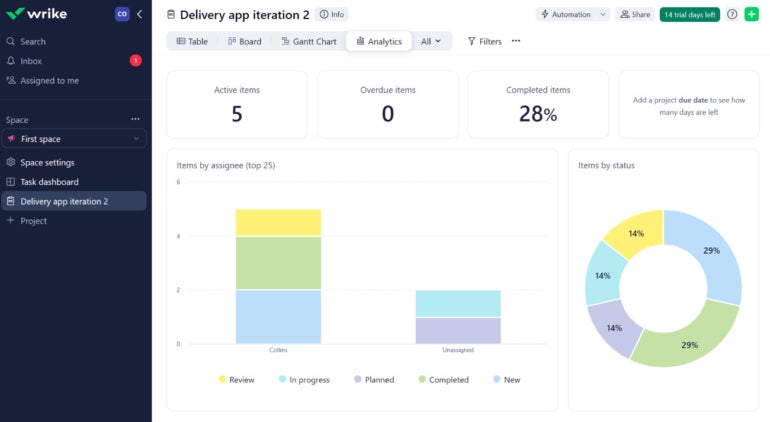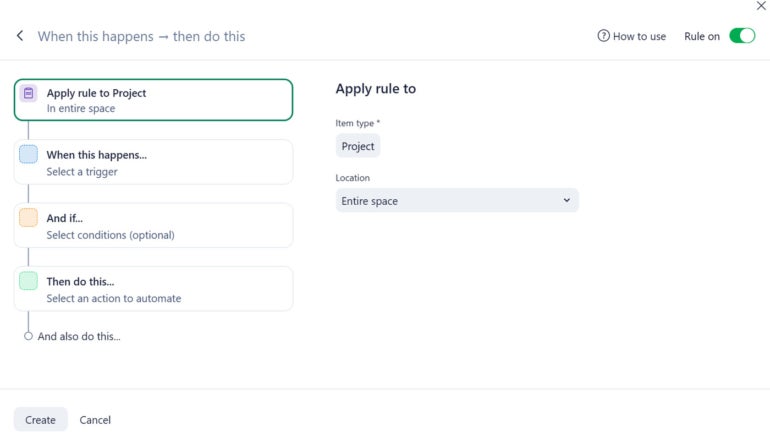Wrike’s fast factsPricing: Free plan available; paid tiers start at $9.80 per user per month. 14-day free trial available. Key features:
|
Featured partners
Wrike is a full-feature project management application suitable for medium to enterprise-level organizations. It is offered as a software-as-a-service tool with a desktop version and mobile app. The user-friendly interface makes it easy for users to transition from spreadsheets to a more visual and intuitive experience.
In this review, we evaluated Wrike’s integration capabilities, pricing plans, pros, cons and standout features. But if Wrike isn’t your ideal choice, we’ve offered a few alternatives as well.
Jump to:
Wrike video review
Wrike pricing plans
In addition to a limited Free plan, Wrike offers a 14-day free trial for its Team, Business, Enterprise and Pinnacle pricing tiers.
Free
With Wrike’s free plan, you get unlimited users and projects with a maximum storage space of 2GB. The unlimited users in a free plan is unusual for top project management software. In the free plan, you also get access to artificial intelligence features such as AI subtask creation.
Team
The Team plan, which starts at $9.80 per user per month, is ideal for small teams that need basic project management tools for collaboration and project planning. In this plan, Wrike offers customizable dashboards, interactive Gantt charts, 50 automations per month, use case templates and other features.
Business
The Wrike Business plan is priced at $24.80 per user per month. You get access to plenty of advanced project management tools in this plan, including calendar views, time tracking and several add-on features, such as Wrike Two-Way Sync with Jira and GitHub.
Enterprise
The Enterprise plan has customized pricing based on your project management needs. The new features in this plan include advanced security and scalability tools. This includes single sign-on two-factor authentication, admin permissions and customer access roles.
Pinnacle
The Pinnacle is the most advanced plan offered by Wrike. Like the Enterprise plan, Pinnacle is offered as a custom quote based on your team’s project management needs. With it, you get complete access to all of Wrike’s features, including advanced resource planning tools, a team dashboard that provides insights into team productivity and an executive-level collaboration space with extra security.
Wrike key features
Integrations
Figure A

Wrike integrates with over 400 popular applications, including email clients, customer relationship management, file storage, messaging apps and more. Some of the most popular third-party integrations (Figure A) include Google Docs, Salesforce, Zoom and Tableau.
In addition, Wrike offers an easy-to-use application programming interface to easily and securely connect tools and workflows to third-party applications.
Collaborators feature
The collaborators feature of Wrike offers a way to provide clients or other users access to Wrike with limited rights. You get a maximum of 20 collaborators or 15% of your license count — whichever is greater.
Collaborators can change task status and comment on or view projects, tasks, spaces, folders and other information based on how the settings are configured for collaborators’ rights.
SEE: Learn more about how to use Wrike features.
Advanced reporting and business intelligence
Figure B

Using the advanced reporting (Figure B) and business intelligence features of Wrike, you can create customer analytics boards or use prebuilt templates. The reports and charts are updated automatically based on the most recent data, so you won’t have to worry about recreating the reports or manually pulling new data.
Workflow automation
Figure C

You can save time by using the workflow automation (Figure C) tools offered by Wrike. This means you can automate most recurring or repetitive tasks to boost your team’s efficiency. Using this feature, you can even automate task approvals, notifications and status updates.
Data security
Wrike includes powerful security tools such as the Wrike Lock, which is an additional layer of encryption on top of the standard encryption for all workspace data and files. Users can also avail of encryption key management for data managed by third-party services or clients.
Marketing insights
This is an add-on feature offered by Wrike for digital marketing teams. You can integrate digital ad campaigns into Wrike to access performance metrics for your marketing campaign.
Wrike ease of use
For all the advanced features offered by Wrike, it is quite user-friendly and adaptable. It is not only easy to use but also easy to set up. Wrike’s interface is well organized, making it easy for users to locate and use various functionalities. It offers a free plan to introduce users to the interface and features, along with a 14-day free trial of the premium plans. For the free trial, it’s easy to sign up and start managing projects as Wrike doesn’t ask you for credit card information, so you can set up projects as quickly as possible.
Wrike customer support
Wrike offers multiple channels of support, including live chat, email and a knowledge base, with many users giving positive feedback about their experience with Wrike’s customer support team, especially citing efficiency and promptness. From its website, Wrike’s Help Center offers two approaches: take advantage of self-service resources or contact customer support and billing teams. The latter has you submit a ticket detailing your issue and wait for Wrike support’s response.
Pros
- Wrike is easy to use with an organized and logical user interface.
- There are a variety of integrations, so you can expand Wrike’s functionality.
- Good learning content and resources are available, so users can learn how to use Wrike’s tools.
Cons
- Advanced security features are only available in the Enterprise plan.
- Wrike is expensive compared to other competitors.
Alternatives to Wrike
While Wrike is outstanding project management software, it might not work for everyone. For example, Wrike might be too expensive for some users or might not offer the required features. In our research for the top project management solutions, we found a few worthy alternatives to Wrike. In the following, we have compared how these alternatives compare to Wrike.
| Software | Wrike | Asana | Trello | monday work management |
|---|---|---|---|---|
| Integrations | 400+ | 100+ | 200+ | 1,000+ |
| Gantt charts | Yes | Yes | Yes | Yes |
| Kanban boards | Yes | Yes | Yes | Yes |
| Issue tracking | Yes | Yes | Yes | Yes |
| Timelines | Yes | Yes | Yes | Yes |
| Mobile app | iOS and Android | iOS and Android | iOS and Android | iOS and Android |
| Free version available | Yes | Yes | Yes | Yes |
| Free trial | 14 days | 30 days | 14 days | 14 days |
| Starting price (per user per month) | $9.80 | $10.99 | $5 | $8 |
Asana

Wrike and Asana offer excellent project management features, including multiple views and automation. However, Asana lacks native time-tracking capabilities, so third-party integration will be needed if you need to use that feature. Another advantage of Wrike is that it has a live editor mode that allows teams to edit and update tasks in real-time.
Comparatively, Asana offers better customization, but the reporting feature is lacking. On the other hand, it provides greater simplicity, so users not experienced in project management might find it easier to start with Asana.
For a closer look, check out our in-depth comparison of Wrike and Asana.
Trello

Trello is well-known for its outstanding free plan, which is loaded with features, as well as its Kanban-style board system, which is extremely easy to use. That said, Trello is missing some key project management features, such as native time tracking.
While Wrike is more suited for larger organizations, Trello is better for individual users, freelancers and smaller businesses looking for an accessible system to get started.
For a closer look, check out our in-depth comparison of Wrike and Trello.
monday work management

monday work management offers everything you would expect from leading project management software. It is comparable in features to Wrike, and both software offer excellent usability through an intuitive user interface.
If you are looking for a Wrike alternative that offers hyper-specific solutions right out of the box, such as modules specifically designed for managing marketing campaigns, then monday work management would be a more suitable application for your needs.
For a closer look, check out our in-depth comparison of Wrike and monday work management.
Frequently asked questions
Is Wrike’s free version worth it?
Absolutely. Wrike’s free version has unlimited users and offers more than half of Wrike’s listed project management tools. For individuals or small teams, this is worth it. While there are limitations compared to the paid versions, users still get access to great project management tools. Plus, the free version is an excellent way to test the platform and determine if it aligns with your needs. However, you should consider upgrading your plan if you want the advanced features of Wrike.
Is Wrike similar to Asana?
While both are great project management tools that offer task management, collaboration tools and integrations with third-party apps, Wrike’s features are more advanced, and the tool is usually a great fit for large teams and enterprises, whereas Asana offers a more balanced experience for teams of all sizes.
What makes Wrike different?
Aside from being able to serve both small and large teams due to its extensive integration capabilities and advanced reporting tools, Wrike has some of the best AI-powered features to enable you to automate your workflows without coding experience.
Is Wrike easy to use?
Yes, Wrike is easy to use as it prioritizes user-friendliness. It has an intuitive onboarding process for first-time users, and it offers a vast variety of templates to ensure starting projects is as easy as possible. Wrike also has some of the most advanced and effective AI features to boost efficiency and simplify and streamline workflows for users, alongside organized dashboards and drag-and-drop features.
What are the limitations of Wrike?
Even though Wrike is feature-rich, the free version’s limitations are in the form of storage space and advanced features. Some users have also reported that the platform becomes more complex as you add more integrations and advanced tools.
Review methodology
To evaluate Wrike, we used a combination of a hands-on review, reputable rankings, customer ratings, testimonials and other expert reviews. We analyzed different parameters in our assessment, including how Wrike compares to other competitors in terms of core features, advanced tools, usability, integration, customer support, security and pricing.
Is Wrike right for your business?
Wrike is quite versatile software; it offers something for all types of users. If you require highly customizable project management software with cross-functional collaboration and don’t mind paying slightly more compared to competitors, Wrike is the right choice for you.
The versatility of Wrike makes it ideal for hyper-growth teams that may need to scale up operations quickly.
Still not sure if Wrike is the best option for you after reading this review? Check out our list of the best Wrike alternatives.
Source of Article



